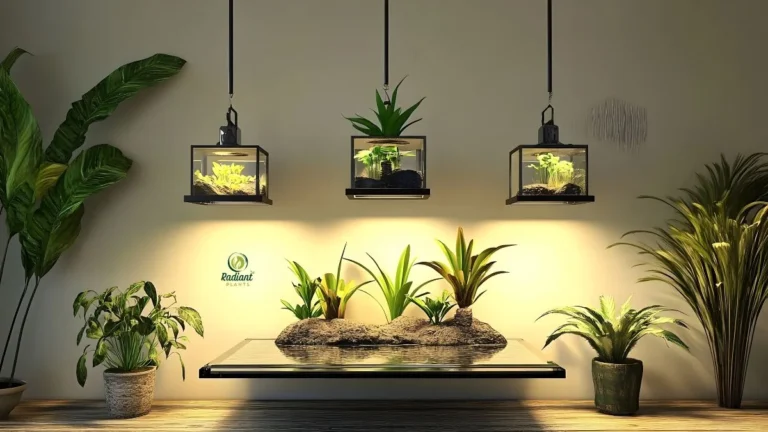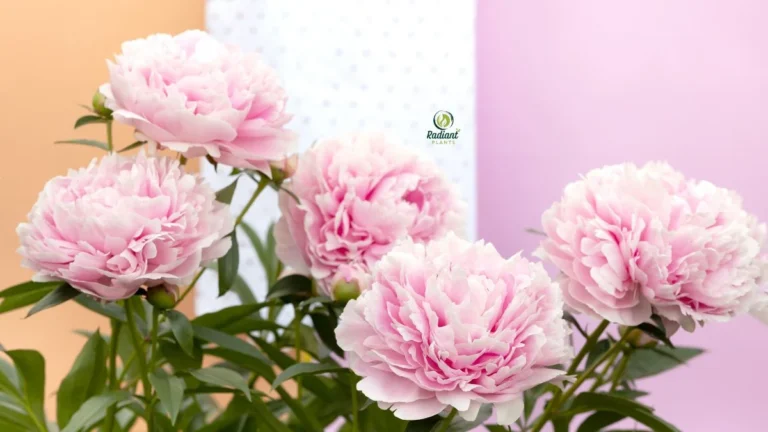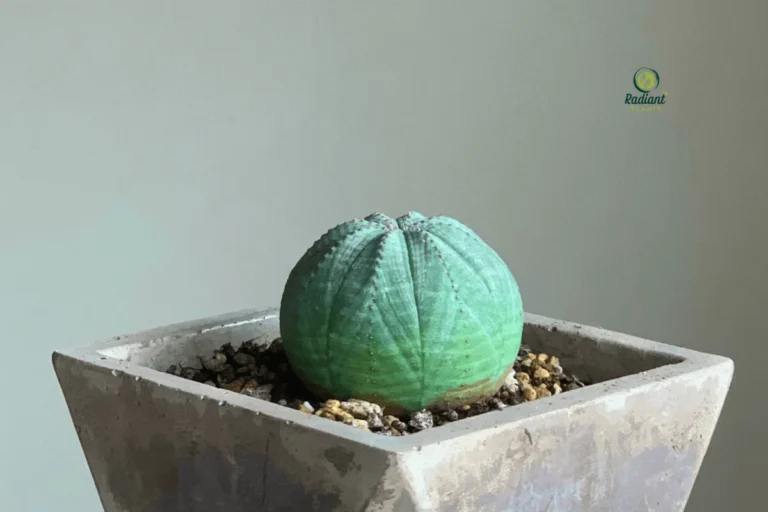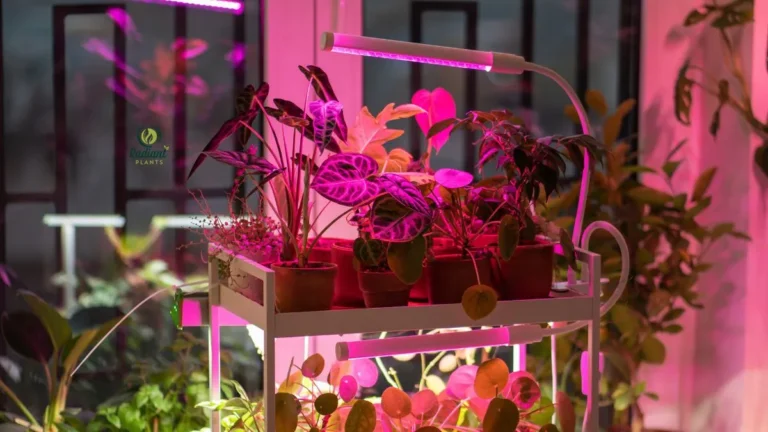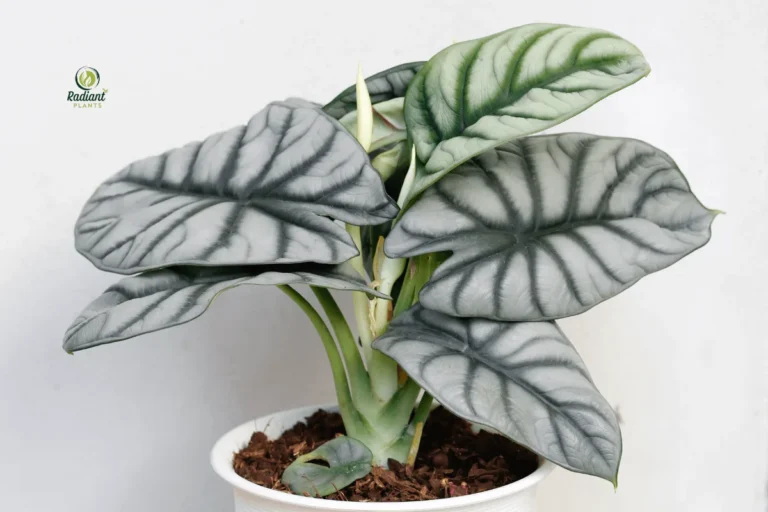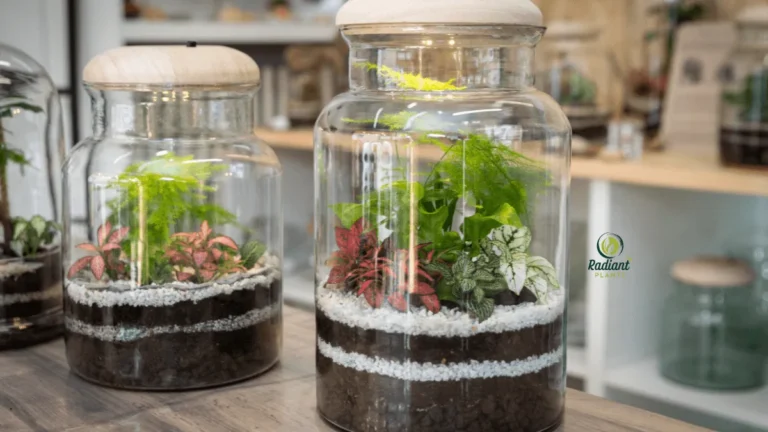Indoor Plant Food: How to Feed Houseplants for Lush Results
Indoor plant food supplies essential nutrients that keep houseplants healthy, green, and growing. According to the Royal Horticultural Society, proper feeding can boost plant vitality by up to 30%. Knowing the right type, timing, and dosage helps you achieve lush results year-round. Let’s explore how to feed your plants like a pro.
Table of Contents
Table of Contents
What Is Indoor Plant Food?
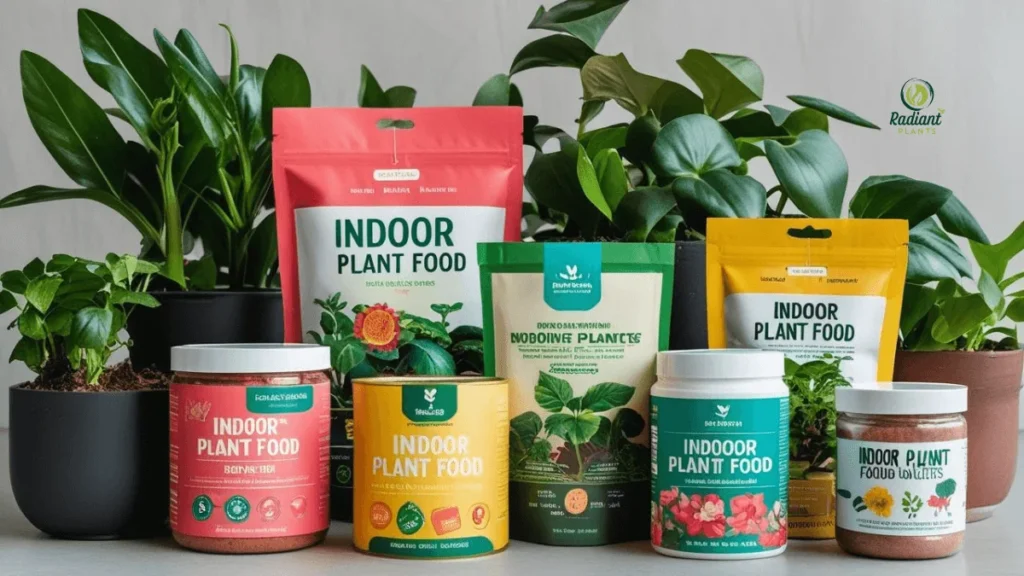
Definition and Purpose
Indoor plant food is a specially formulated blend of nutrients designed to supplement what houseplants can’t get from regular potting soil. Over time, watering naturally leaches nutrients from the soil, leaving plants vulnerable to slow growth, yellowing leaves, or weak stems. Unlike garden compost or outdoor fertilizers, indoor plant food is specifically formulated for container-grown plants, providing precise ratios of nitrogen (N), phosphorus (P), and potassium (K), along with essential trace minerals such as magnesium, calcium, and iron.
According to the Royal Horticultural Society (RHS), targeted feeding helps maintain healthy leaf color, promotes flowering, and strengthens roots, especially in plants kept indoors where natural nutrient replenishment is limited. In short, indoor plant food isn’t a luxury—it’s essential maintenance for long-term plant vitality.
Common Forms
Indoor plant food comes in several forms, each suited to different care routines:
- Liquid fertilizers – Fast-acting, ideal for quick nutrient absorption; added to water during regular watering.
- Granules or powders – Mixed into the topsoil for gradual nutrient release; effective for consistent feeding over weeks.
- Slow-release spikes or pellets – Inserted into the soil, releasing nutrients steadily over months; perfect for low-maintenance plant care.
Horticulture experts at the University of Florida recommend matching the form to your plant type, growth stage, and your care schedule. For example, flowering plants may benefit from more frequent liquid feeds, while foliage-heavy species can thrive with slow-release options.
Benefits of Using Indoor Plant Food
Promotes Healthy Growth
Indoor plant food delivers a balanced mix of essential macronutrients—nitrogen (N) for lush leaf growth, phosphorus (P) for strong root systems, and potassium (K) for overall plant health. According to the University of Minnesota Extension, container plants rely entirely on the grower for nutrient replenishment, making consistent feeding crucial. For example, peace lilies often produce larger, glossier leaves when given a diluted liquid fertilizer every 2–4 weeks during the growing season. This targeted nutrition helps plants maintain vibrant foliage, sturdy stems, and steady growth even in low-light indoor environments.
Prevents Nutrient Deficiency
Without regular feeding, potted plants can quickly exhaust the nutrients in their soil. Common deficiency signs include:
- Nitrogen shortage – pale or yellowing older leaves.
- Phosphorus shortage – stunted growth, dull or purplish leaves.
- Potassium shortage – leaf edges turning brown or scorched.
The Royal Horticultural Society warns that nutrient deficiencies can slow recovery even after feeding begins. By using indoor plant food on a proper schedule, you ensure your plants avoid these setbacks and stay in peak condition year-round.
Improves Flowering and Longevity
For flowering and ornamental plants, the right indoor plant food can mean the difference between a single bloom and a full, lasting display. Fertilizers with a slightly higher phosphorus content encourage strong bud formation and vibrant flowers. The American Horticultural Society notes that consistent feeding can extend the blooming period of orchids, African violets, and other ornamentals by several weeks. Additionally, balanced nutrition strengthens the plant’s immune response, reducing the likelihood of disease or premature decline, helping your indoor garden stay beautiful for years.
How to Choose the Right Indoor Plant Food
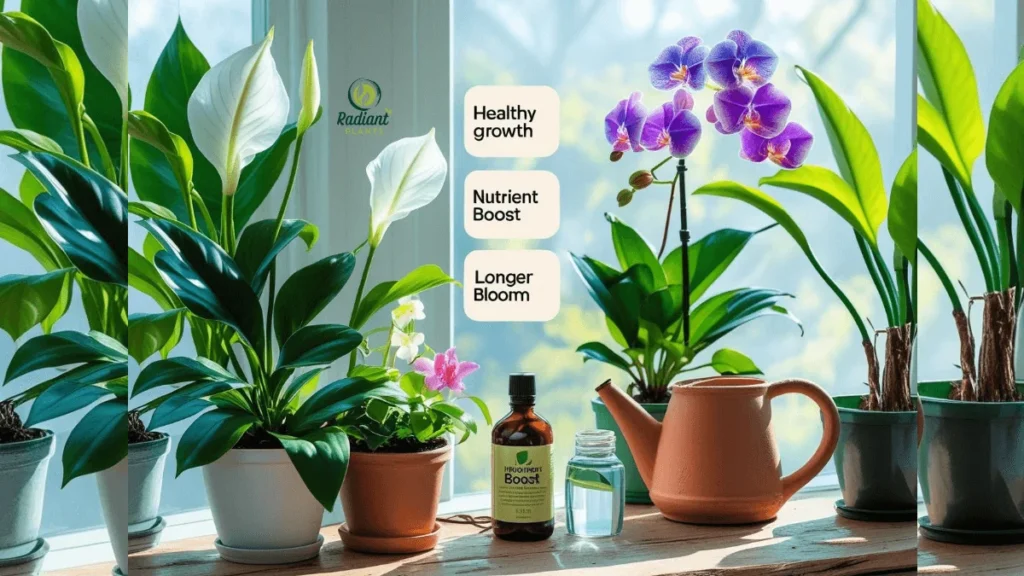
Selecting the right indoor plant food can make a significant difference in your houseplants’ growth, appearance, and overall health. The right choice depends on understanding nutrient ratios, deciding between organic and synthetic options, and matching the product to your plant’s specific needs. Below, we break down each factor with expert-backed guidance.
Understand N-P-K Ratios
The N-P-K ratio—printed on every fertilizer package—represents the percentage of nitrogen (N), phosphorus (P), and potassium (K) in the product:
- Nitrogen (N): Encourages lush, green leaf growth. Plants like pothos, ferns, and monstera thrive with higher nitrogen during active growth.
- Phosphorus (P): Supports root development and flower production. Essential for flowering plants such as African violets and orchids.
- Potassium (K): Enhances overall plant health, disease resistance, and strong stem growth.
For most houseplants, the University of Florida’s IFAS Extension recommends a balanced formula such as 10-10-10 or 20-20-20 during the growing season, with adjustments based on plant type and growth stage. For example, a 15-30-15 mix benefits blooming orchids, while leafy herbs may prefer higher nitrogen. Always follow package dilution instructions to avoid nutrient burn.
Organic vs. Synthetic Options
Indoor plant food is available in both organic and synthetic forms, each with unique benefits and limitations:
Organic Plant Food
- Pros:
- Derived from natural materials like compost, seaweed, or bone meal.
- Improves soil health and microbial activity over time.
- Lower risk of overfertilization due to slower nutrient release.
- Cons:
- Nutrients are released gradually, so results may take longer.
- It can produce odors indoors if not processed properly.
Synthetic Plant Food
- Pros:
- Delivers nutrients quickly for fast results.
- Precisely formulated for specific plant needs (e.g., high-bloom or foliage formulas).
- Often more concentrated, requiring less product per use.
- Cons:
- Overuse can lead to salt buildup in the soil.
- Does not improve long-term soil structure.
In a 2024 product test by Better Homes & Gardens, synthetic fertilizers showed visible growth improvements within 2–3 weeks, while organic options built healthier soil conditions over a longer period. The choice depends on whether you prioritize speed or long-term sustainability.
Plant-Specific Needs
Different indoor plants respond best to specific nutrient balances and feeding frequencies:
- Orchids: Require a bloom-boosting formula with higher phosphorus (e.g., 15-30-15) every 2–4 weeks during the flowering season.
- Succulents & Cacti: Prefer a diluted, low-nitrogen formula (e.g., 2-7-7) to avoid excessive leaf growth that weakens structure. Feed only during active growing months.
- Tropical Foliage Plants (Monstera, Philodendron): Benefit from balanced NPK formulas (e.g., 20-20-20) every 2 weeks in spring and summer, reduced in fall/winter.
- Herbs (Basil, Mint, Parsley): Thrive with higher nitrogen for leaf production, but avoid overfeeding to maintain flavor intensity.
Research from the Royal Horticultural Society emphasizes that tailoring feeding schedules to plant type and growth phase improves outcomes significantly. Keeping a simple feeding log helps track results and avoid overfertilizing, a common cause of plant stress in home environments.
When and How to Feed Indoor Plants
Feeding houseplants with the right indoor plant food at the right time can significantly improve growth, color, and overall health. Timing, dosage, and application method all influence how effectively your plants absorb nutrients. The following seasonal guide, dosage tips, and feeding steps will help you create an optimal routine.
Seasonal Feeding Guide
Indoor plants have distinct feeding needs depending on the season, even when grown in stable indoor conditions.
- Spring & Summer (Active Growth):
This is the prime feeding season. Most houseplants actively produce new leaves, flowers, or roots, meaning nutrient demands are higher. The Royal Horticultural Society recommends feeding every 2–4 weeks with a balanced formula during this time. Flowering plants may require more phosphorus-rich blends. - Autumn (Slowing Growth):
Gradually reduce feeding frequency to once every 4–6 weeks. Shorter daylight hours naturally slow plant metabolism, so excess fertilizer can lead to salt buildup in the soil. - Winter (Dormancy):
Many tropical and temperate plants enter a semi-dormant phase indoors. Unless actively growing under grow lights, most will not need fertilizer. Feeding during this period can stress roots and cause nutrient burn. Succulents and cacti especially, should be left unfed until growth resumes.
Correct Dosage and Dilution
Using too much indoor plant food is one of the most common mistakes in houseplant care. Overfertilization can cause leaf burn, root damage, and soil toxicity.
Best practices for dosage:
- Always follow the manufacturer’s dilution instructions—never assume “more is better.”
- For sensitive plants (ferns, calatheas, orchids), use half the recommended strength.
- Test water pH if possible; improper pH can limit nutrient absorption even when fertilizing correctly.
Dr. Leonard Perry, Professor Emeritus at the University of Vermont, warns that “overfeeding can be more harmful than underfeeding” because nutrient salts accumulate in potting mixes over time. Flushing soil with plain water every 2–3 months helps prevent this buildup.
Step-by-Step Feeding Instructions
For Liquid Fertilizers:
- Dilute according to label directions.
- Water plants lightly first to prevent root shock.
- Apply the nutrient solution evenly over the soil surface.
- Wipe away any splashes on leaves to avoid leaf burn.
For Granules or Powders:
- Measure the recommended amount.
- Sprinkle evenly over the soil surface.
- Water thoroughly to help nutrients penetrate the root zone.
For Slow-Release Spikes or Pellets:
- Insert spikes into moist soil, spaced evenly around the pot.
- Replace according to package timing—usually every 1–3 months.
Common Mistakes to Avoid:
- Feeding during dormancy, when plants aren’t actively growing.
- Doubling the dosage to “speed up” growth.
- Using outdoor fertilizers indoors without checking nutrient ratios.
- Ignoring plant-specific needs (e.g., orchids vs. succulents).
By aligning seasonal timing with correct dosage and application methods, you’ll ensure your indoor plants get the nutrients they need, without risking overfertilization.
DIY Indoor Plant Food Recipes
Making your indoor plant food can be an affordable, eco-friendly way to nourish your houseplants—provided you use safe, effective ingredients. While homemade fertilizers can’t always match the precision of commercial formulas, they can supplement nutrients and improve soil health when used correctly. Below are tried-and-tested options, along with ingredients you should avoid to keep your plants safe.
Safe Homemade Options
1. Compost Tea
- How to make: Fill a bucket or large container with water, add a mesh bag of mature compost, and steep for 24–48 hours. Strain and use the nutrient-rich liquid to water plants.
- Benefits: Supplies a broad range of micronutrients and beneficial microbes. The University of California Cooperative Extension notes that compost tea can improve soil biology and nutrient uptake.
- Best for: Leafy tropicals like pothos, philodendron, and ferns.
2. Banana Peel Water
- How to make: Chop fresh banana peels, soak them in a jar of water for 2–3 days, then strain.
- Benefits: Adds potassium and phosphorus, which support root development and flowering.
- Best for: Flowering plants like African violets, orchids, and hibiscus.
3. Seaweed Extract
- How to make: Purchase dried seaweed (unsalted), soak in water for 24 hours, and strain the liquid. Alternatively, use commercially available liquid kelp.
- Benefits: Provides trace minerals and natural growth hormones. According to the Royal Horticultural Society, seaweed extract can enhance root growth and stress resistance.
- Best for: All-purpose use, especially for plants recovering from stress or transplanting.
Usage Tip: Always dilute homemade liquid feeds to half-strength before applying, and test on a single plant before widespread use.
Ingredients to Avoid
While many household scraps are touted as “miracle fertilizers,” some can harm indoor plants or attract pests.
- Coffee Grounds:
- Problem: High acidity can alter soil pH, and wet grounds can encourage mold growth indoors.
- Expert insight: The University of Minnesota Extension warns that coffee grounds may inhibit seedling growth if used fresh and unprocessed.
- Excess Salt:
- Problem: Table salt, salted cooking water, or brined foods can cause root dehydration and leaf burn.
- Why it matters: Indoor plants have limited soil volume, making salt buildup more concentrated and damaging.
- Unprocessed Kitchen Waste:
- Problem: Raw food scraps (like vegetable peels, eggshells, or meat) decompose slowly indoors, creating odor and attracting fruit flies or fungus gnats.
- Safe alternative: Compost these materials outdoors, then use finished compost to make compost tea.
General Safety Guidelines:
- Avoid adding any ingredient with oils, fats, dairy, or meat byproducts.
- Stick to proven recipes and measure quantities to prevent overfeeding.
- Observe plants for 7–10 days after applying a new homemade feed—if leaves yellow, curl, or drop, discontinue use immediately.
By combining safe, proven DIY recipes with a clear understanding of what to avoid, you can make homemade indoor plant food that supports healthy growth without risking plant health. This approach works best as a supplement to, not a complete replacement for, well-balanced commercial fertilizers.
Troubleshooting Plant Feeding Problems
Even with the best intentions, using indoor plant food incorrectly can cause more harm than good. Overfeeding is one of the most common mistakes in houseplant care, often leading to visible stress symptoms. Recognizing these early signs and taking corrective action can save your plants from long-term damage.
Signs of Overfeeding
When plants receive more nutrients than they can process, the excess builds up in the soil, often as soluble salts. This disrupts water uptake and can damage root tissues. Common symptoms include:
- Yellow Leaves (Chlorosis): Typically starting at the tips or edges before spreading inward. Often caused by nutrient imbalance or root burn from excess fertilizer salts.
- Burnt or Brown Leaf Tips: A clear sign of salt buildup, drawing moisture out of plant cells. Particularly common in peace lilies, dracaenas, and spider plants.
- White Crust on Soil or Pot Rim: Mineral deposits from repeated feeding without adequate flushing.
- Wilting Despite Moist Soil: Damaged roots can’t absorb water efficiently, even when the soil is damp.
The University of California Agriculture & Natural Resources division notes that excess nitrogen, especially from quick-release synthetic fertilizers, can accelerate these issues, stunting overall growth.
How to Correct Issues
If you suspect overfeeding, act quickly to reverse the damage. Here’s an expert-backed approach:
1. Flush the Soil
- Move the plant to a sink or shower.
- Slowly pour room-temperature water through the soil until it drains freely from the bottom, repeating 2–3 times.
- This process leaches out excess salts without harming the plant.
- Tip: Allow the soil to drain completely to avoid root rot.
2. Adjust Feeding Schedule
- Skip fertilization for at least 4–6 weeks to let the plant recover.
- Resume feeding at half the previous dosage and only during active growth periods.
- Keep a simple log of feeding dates and fertilizer types to avoid accidental over-application.
3. Repot if Necessary
- If the salt crust is heavy or the roots show severe burn, consider repotting into fresh, well-draining potting mix.
- Use a pot with adequate drainage holes to prevent nutrient concentration in the soil.
4. Monitor Recovery
- New growth should appear healthy and green within a few weeks.
- Remove any dead or severely damaged leaves to redirect energy to new growth.
Pro Tip: Dr. Leonard Perry of the University of Vermont Extension advises that prevention is the best cure—measure carefully, dilute when in doubt, and always match the fertilizer type to the plant’s seasonal needs.
By recognizing early warning signs and applying these corrective steps, you can protect your houseplants from long-term nutrient damage and restore them to full health. Proper use of indoor plant food is all about balance—giving just enough for lush growth without tipping into harmful excess.
Best Indoor Plant Food Products (Expert Picks)
Finding the right indoor plant food can be overwhelming given the wide range of products on the market. Below, we’ve curated expert-recommended picks based on independent product tests, horticultural research, and positive consumer feedback. Each option is chosen for its proven nutrient profile, ease of use, and overall effectiveness in promoting plant health.
Top Liquid Fertilizers
Liquid fertilizers are favored for their fast nutrient delivery and ease of dosage adjustments. They’re ideal for plants that need quick nutrient absorption during active growth.
- Miracle-Gro Indoor Plant Food (Liquid Concentrate)
- Why experts recommend it: Delivers a balanced 1-1-1 NPK ratio suitable for most houseplants. Shows visible results within 7–14 days according to Better Homes & Gardens product testing.
- Best for: General indoor use, including tropical foliage and herbs.
- Application: Mix 4 pumps per liter of water; feed every 1–2 weeks in active seasons.
- Dyna-Gro Grow 7-9-5
- Why experts recommend it: It contains all 16 essential minerals, including calcium and magnesium, for comprehensive plant nutrition.
- Best for: Fast-growing foliage plants and flowering species.
- Application: Dilute to half-strength for sensitive plants like ferns and calatheas.
Pro Tip: The University of Florida Extension advises using liquid feeds in conjunction with regular watering to avoid nutrient burn.
Best Organic Options
Organic indoor plant food enhances soil biology while delivering nutrients in a slower, more controlled manner. This approach is ideal for long-term plant health and sustainability.
- Espoma Organic Indoor! Houseplant Food
- Why experts recommend it: Derived from natural sources like poultry manure and kelp extract. Safe for organic gardening and OMRI-listed.
- Best for: All-purpose feeding, especially for eco-conscious plant owners.
- Application: Mix 2 teaspoons per quart of water; apply every 2–4 weeks.
- Neptune’s Harvest Seaweed Plant Food
- Why experts recommend it: Rich in trace minerals and natural plant growth hormones. The Royal Horticultural Society notes that seaweed extracts can improve root development and stress tolerance.
- Best for: Orchids, ferns, and plants recovering from stress.
- Application: Dilute per label and mist leaves for foliar feeding benefits.
Recommended Slow-Release Spikes
Slow-release spikes provide steady nutrition over weeks or months, making them perfect for low-maintenance care or plants in hard-to-reach spots.
- Jobe’s Houseplant Fertilizer Spikes (13-4-5)
- Why experts recommend it: Delivers a steady nutrient supply for up to 60 days; minimizes the risk of overfeeding.
- Best for: Pothos, snake plants, and other easy-care foliage.
- Application: Insert spikes into moist soil according to pot size.
- Osmocote Smart-Release Plant Food
- Why experts recommend it: Balanced NPK (14-14-14) with micronutrients; coated granules release nutrients in response to temperature and moisture.
- Best for: Mixed indoor collections where plants share similar nutrient needs.
- Application: Sprinkle and mix lightly into the topsoil; lasts up to 6 months.
Expert Insight: Dr. Leonard Perry, University of Vermont Extension, emphasizes that while spikes are convenient, they may not suit plants needing targeted nutrient changes throughout the year. Combine with occasional liquid feeding for best results.
By choosing a product tailored to your plant’s needs—whether it’s quick-acting liquid feed, long-term organic nourishment, or maintenance-friendly spikes—you’ll maximize the benefits of indoor plant food while reducing the risk of over- or underfeeding. Always follow label instructions and monitor your plant’s response to fine-tune your feeding routine.
FAQ – Indoor Plant Food
What is the best indoor plant food for houseplants?
The best indoor plant food is one that matches your plant’s needs, such as a balanced 20-20-20 formula for foliage plants or a bloom-boosting mix for flowers. Choose a reputable brand and follow the dosage instructions for healthy, consistent growth.
How often should I feed indoor plants with plant food?
Most indoor plants should be fed every 2–4 weeks during active growth in spring and summer. Reduce or stop feeding in fall and winter unless plants are under grow lights and actively producing new leaves or flowers.
Why do indoor plants need plant food?
Indoor plants need plant food because nutrients in potting soil deplete over time through watering and plant uptake. Feeding replenishes essential elements like nitrogen, phosphorus, and potassium, ensuring strong roots, healthy leaves, and vibrant blooms.
When should I stop feeding my indoor plants?
Stop feeding indoor plant food during dormancy, typically in late fall and winter, unless the plant is actively growing. Feeding during rest periods can lead to salt buildup in the soil and damage the roots.
Can I make homemade indoor plant food?
Yes, you can make homemade indoor plant food using safe recipes like compost tea, banana peel water, or diluted seaweed extract. Always avoid ingredients that cause harm, such as excess salt, coffee grounds, or unprocessed kitchen scraps.
Feeding your plants with the right indoor plant food ensures they get the nutrients needed for vibrant growth, healthy roots, and long-lasting blooms. By choosing the right formula, following seasonal feeding schedules, and avoiding common mistakes, you’ll keep your houseplants thriving year-round. Ready to take your plant care to the next level? Subscribe to our newsletter for expert tips, DIY recipes, and product recommendations delivered straight to your inbox.


